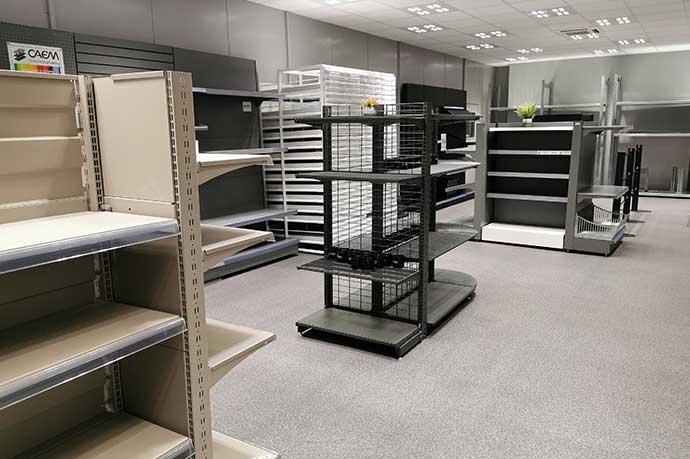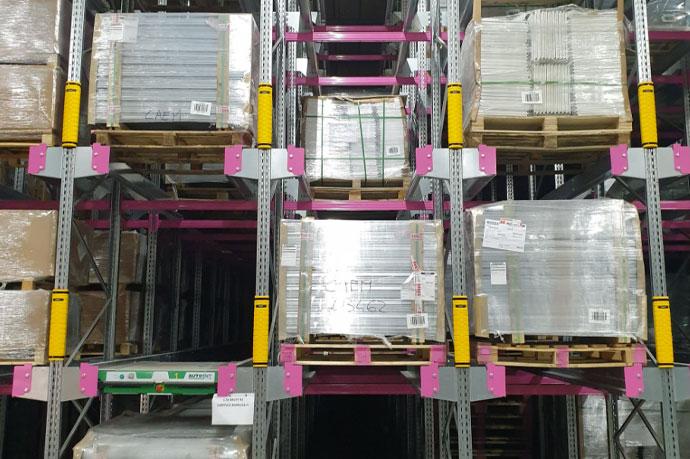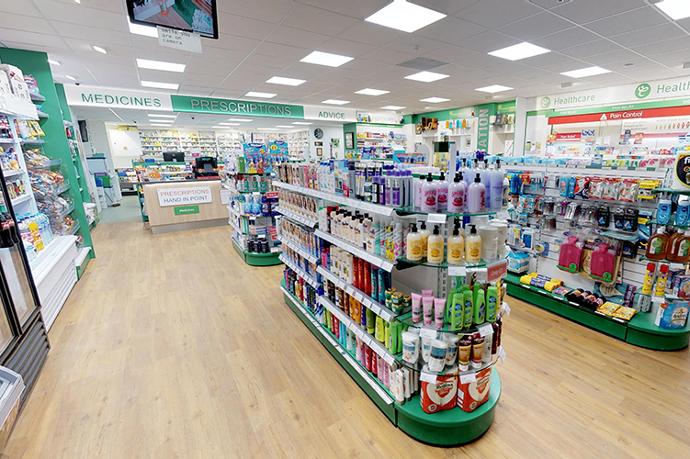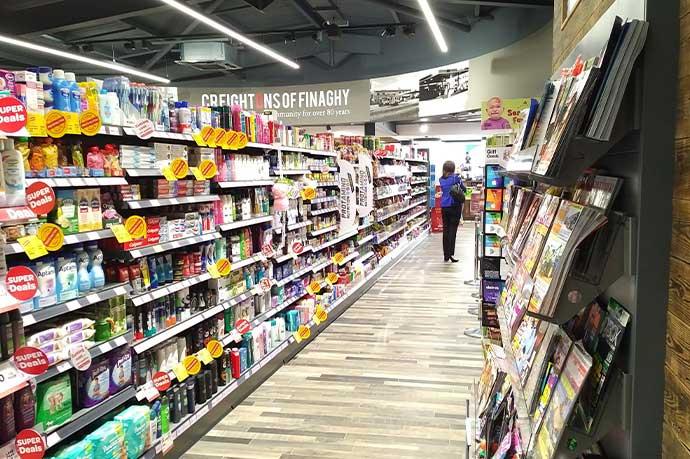In the bustling world of retail, first impressions are everything. The moment a customer steps into your store, they're immersed in an experience crafted by the subtle art of shop fitting. But who are the masterminds behind these captivating retail environments? Enter the unsung heroes of the retail world: shop fitting suppliers. These wizards of retail design transform empty spaces into vibrant, inviting shopping havens that not only showcase products but also tell a brand's unique story. As we delve into the realm of top-tier shop fitting suppliers, we'll uncover the secrets behind quality displays and shelving that can elevate any retail space from ordinary to extraordinary.
Introduction to Shop Fitting Suppliers in the UK
The United Kingdom has long been a hub for innovative retail design, and at the heart of this industry are the shop fitting suppliers who bring retail visions to life. These specialized companies play a crucial role in shaping the face of British retail, from high street boutiques to sprawling department stores. As a trusted business manufacturing in the UK since 1989, I've witnessed firsthand the evolution of shopfitting and its impact on the retail landscape.
Shop fitting suppliers in the UK are more than just providers of shelves and display units. They are partners in creating immersive retail environments that captivate customers and drive sales. These suppliers offer a comprehensive range of services, from design consultation to custom fabrication and installation of fixtures. Their expertise spans across various retail sectors, ensuring that whether you're outfitting a fashion boutique or a gourmet food store, there's a supplier with the right experience to meet your needs.
One of the hallmarks of UK shopfitting companies is their commitment to quality and innovation. Many of these suppliers, including those manufacturing in the UK, pride themselves on using cutting-edge technology and sustainable materials to create durable, aesthetically pleasing fixtures. This dedication to excellence has led to UK-based suppliers being sought after by major retailers not just within the country, but internationally as well.
The shopfitting industry in the UK is diverse, with suppliers ranging from small, specialized workshops to large-scale manufacturers capable of outfitting entire retail chains. This variety ensures that retailers of all sizes can find a supplier that aligns with their vision and budget. Moreover, the close-knit nature of the UK market means that many shopfitters have established long-standing relationships with retailers, leading to a deep understanding of brand identities and evolving consumer preferences.
Comprehensive Guide to Choosing Your Shop Fitting Supplier
When it comes to selecting the right shop fitting suppliers for your retail space, the decision can be as crucial as choosing your product line. The perfect supplier can transform your vision into a tangible, attractive reality that resonates with your customers. Here's a comprehensive guide to help you navigate this important choice:
- Assess Their Experience and Portfolio
- Look for suppliers with a proven track record in your specific retail niche.
- Review their portfolio to ensure their style aligns with your brand aesthetic.
- Evaluate Their Design Capabilities
- Seek suppliers offering a design and prototype service.
- Ensure they have a dedicated design team to convert your display idea into reality.
- Consider Manufacturing Location
- Opt for shop fitting suppliers who manufacture in the UK for quicker turnaround and easier communication.
- Check for Customization Options
- The best suppliers offer bespoke solutions tailored to your unique needs.
- Assess Quality and Durability
- Request samples to evaluate the quality of materials and craftsmanship.
- Review Their Project Management Skills
- Efficient suppliers should offer end-to-end project management, from design to installation.
- Investigate Their Sustainability Practices
- Choose suppliers committed to eco-friendly materials and manufacturing processes.
- Analyze Cost-Effectiveness
- While price is important, focus on value for money rather than just the lowest bid.
- Check for After-Sales Support
- Reliable shop fitting suppliers offer maintenance and repair services post-installation.
- Seek Client Testimonials
- Reach out to their past clients to gauge satisfaction levels and reliability.
Meeting Specific Retail Needs
Every retail sector has its unique requirements, and the best shop fitting suppliers understand this implicitly. Whether you're in fashion, electronics, or gourmet foods, your displays and shelving need to cater to your specific products and customer base.
For fashion retailers, versatile and adjustable displays are crucial. Look for suppliers who offer modular systems that can be easily reconfigured to showcase changing collections. Lighting integration is also key in this sector, so prioritize suppliers who can incorporate effective lighting solutions into their designs.
In the electronics sector, security is paramount. Seek out shop fitting suppliers who specialize in secure display cases and anti-theft solutions without compromising on the customer's ability to interact with products. Additionally, consider suppliers who can integrate charging stations and live demo units into their designs.
For food and beverage retailers, hygiene and temperature control are non-negotiable. Your chosen supplier should have experience in creating food-safe displays and refrigerated units. They should also understand the importance of creating an inviting atmosphere that encourages browsing and sampling.
Bookstores and gift shops often require a mix of open shelving and specialized display units. Look for suppliers who can provide a balance of functional storage and attractive product presentation, with options for highlighting featured items or creating themed sections.
Ultimately, the key to meeting specific retail needs lies in finding shop fitting suppliers who take the time to understand your business. They should offer a design and prototype service that allows you to visualize and refine your ideas before committing to full production. With a dedicated design team to convert your display idea into reality, you can ensure that your retail space not only meets but exceeds your expectations and those of your customers.
Shopfittings & Retail Display Systems
In the dynamic world of retail, the right shop fittings and display systems can make all the difference in creating an engaging shopping experience. As the global shopfitting service market continues to expand, with projections indicating growth from USD 88 billion to USD 173 billion between 2024 and 2031, retailers are increasingly recognizing the importance of innovative display solutions.
At the heart of this growth are versatile and customizable shop fittings that cater to diverse retail needs. CAEM, a leading manufacturer in this space, exemplifies the innovation driving the industry forward. With over 30 years of experience in the UK market, CAEM has developed a comprehensive range of shelving systems and modular solutions that are transforming retail spaces across the country.
One of the standout offerings in the realm of shop display fittings is CAEM's TN9 system. This fully modular shelving system is built around a unique and versatile upright, allowing for endless configuration possibilities. Such flexibility is crucial in today's retail environment, where adaptability can make or break a store's success.
For retailers seeking compatibility with existing setups, the S50 shelving system offers 50mm compatibility, ensuring seamless integration with a wide range of retail fixtures. Meanwhile, the M25 system pushes the boundaries of space optimization with its ultra-low base, slim shelves with hinged EPOS, and central back panels – features that maximize merchandising potential in any retail setting.
The importance of storage solutions in retail cannot be overstated, and CAEM's Unizinc 4-post storage shelving system addresses this need head-on. This robust system provides efficient storage options that can be seamlessly integrated into the overall shop design.
Beyond traditional shelving, CAEM has expanded its offerings to include specialized furniture programmes. The D25 modular drawer system, for instance, caters to the unique needs of pharmacies and hospitals, demonstrating the company's ability to adapt to specific industry requirements.
What sets CAEM apart in the competitive landscape of shop fitting suppliers is their commitment to customization and quality. With state-of-the-art automatic manufacturing capabilities, CAEM can produce retail fixtures available in any colour, allowing brands to maintain visual consistency across their stores. This level of customization is crucial in an industry where the global shopfitting service market is anticipated to reach US$ 2030 million by 2030, driven by retailers' need for unique and branded environments.
The company's strong team of designers works closely with retailers to convert their requirements into bespoke solutions in a short time frame. This collaborative approach has led to the development of complete store formats, with some stores featuring hundreds of custom display solutions. Such comprehensive offerings are invaluable for retailers looking to create cohesive and branded shopping experiences.
In today's retail landscape, display fixtures and retail fixtures are more than just functional items – they are integral components of the brand story and customer journey. From retail shop counters that serve as focal points for customer interactions to innovative shelving systems that showcase products in their best light, every element plays a crucial role in the overall shopping experience.
As the retail industry continues to evolve, the demand for sophisticated shop fittings and display systems will only grow. Companies like CAEM, with their commitment to innovation, customization, and quality, are well-positioned to meet this demand, helping retailers create compelling spaces that attract and retain customers in an increasingly competitive marketplace.
Top Categories and Best Sellers in Shop Fittings
The shop fittings industry is experiencing remarkable growth, with the global shop fitting materials market projected to reach US$ 234.1 billion by 2031, growing at a CAGR of 4.5% from 2023 to 2031. This expansion is driven by the increasing demand for innovative and customized retail environments. Let's explore the top categories and best-selling products that are shaping the future of retail spaces.
- Modular Shelving Systems
Modular shelving systems remain the backbone of retail shop fittings. CAEM's TN9 system exemplifies this category, offering unparalleled versatility with its unique upright design. This fully modular system allows retailers to create dynamic displays that can be easily reconfigured to meet changing needs. The adaptability of such systems is crucial in today's fast-paced retail environment, where product lines and promotional displays change frequently.
- Customizable Display Fixtures
The customized shopfitting materials market size was valued at over USD 131.5 billion in 2018 and is anticipated to reach USD 180 billion by 2025. This growth underscores the importance of tailored display fixtures in modern retail. CAEM's S50 shelving, with its 50mm compatibility, represents this trend by offering retailers the flexibility to integrate with existing setups while providing a fresh look.
- Space-Optimizing Solutions
With retail real estate at a premium, space-optimizing shop display fittings are in high demand. CAEM's M25 system, featuring an ultra-low base and slim shelves with hinged EPOS, exemplifies this category. These features allow retailers to maximize merchandising space without compromising on aesthetics or functionality.
- Retail Shop Counters
The customized shopfitting materials market from furniture application is anticipated to surpass USD 80 billion by 2025. Within this segment, retail shop counters are crucial elements that serve both functional and aesthetic purposes. Modern counters often incorporate technology, such as integrated POS systems and digital displays, enhancing the customer checkout experience.
- Specialized Industry Solutions
Different sectors require tailored shop fittings. For instance, the customized shopfitting materials market from pharmacy may witness gains at over 3.5% by 2025. CAEM's D25 modular drawer system, designed specifically for pharmacies and hospitals, addresses this need for specialized retail shop fittings.
- Storage Solutions
Efficient storage is critical in retail environments. CAEM's Unizinc 4-post storage shelving system is a prime example of how storage solutions can be both functional and aesthetically pleasing, integrating seamlessly with other shop display fittings.
- Eco-Friendly Materials
With sustainability becoming increasingly important, eco-friendly shop fittings are gaining popularity. Retailers are seeking display fixtures made from recycled or sustainable materials that don't compromise on quality or design.
- Tech-Integrated Display Fixtures
As retail continues to blend digital and physical experiences, display fixtures with integrated technology are becoming best-sellers. These might include interactive touchscreens, digital price tags, or augmented reality capabilities.
- Flexible and Movable Units
The customized shopfitting materials market from airports may surpass USD 30 billion by 2025, highlighting the need for flexible and movable shop fittings in high-traffic, multi-use spaces. Lightweight, easy-to-move display units that can be quickly reconfigured are increasingly popular.
- Customizable Color Options
CAEM's ability to offer shop fittings in any color reflects the growing demand for brand-aligned retail environments. This customization allows retailers to create cohesive, branded spaces that enhance the overall shopping experience.
The diversity and innovation in these top categories reflect the dynamic nature of the retail industry. As Asia Pacific's customized shopfitting materials market size is projected to surpass USD 75 billion by 2025, and Europe's market is expected to grow by 4.5% in the same period, it's clear that the demand for high-quality, versatile shop fittings is global. Companies like CAEM, with their comprehensive range of products and commitment to innovation, are well-positioned to meet this growing demand and shape the future of retail spaces worldwide.
Why Ethical Sourcing and Sustainability Matter in Shop Fittings
In today's retail landscape, the importance of ethical sourcing and sustainability in shop fittings cannot be overstated. As consumers become increasingly environmentally conscious, retailers are recognizing that their commitment to sustainability must extend beyond the products they sell to encompass every aspect of their store's design and infrastructure.
Ethical sourcing in shop fittings involves ensuring that the materials and labor used in creating display fixtures and shelving systems are obtained through fair and responsible means. This approach not only supports better working conditions and fair wages throughout the supply chain but also helps to build a positive brand image that resonates with socially conscious consumers.
Sustainability in shop fittings goes hand in hand with ethical sourcing. It focuses on using eco-friendly materials, implementing energy-efficient designs, and considering the entire lifecycle of retail fixtures. Sustainable shop fittings are designed to be durable, recyclable, and have a minimal environmental impact from production to disposal.
Here's why ethical sourcing and sustainability in shop fittings are crucial:
- Environmental Impact Reduction Sustainable shop fittings often use recycled or renewable materials, reducing the demand for new resources and minimizing waste. For example, shelving units made from recycled plastics or sustainably sourced wood help to lower the carbon footprint of retail spaces.
- Energy Efficiency Modern, sustainable shop fittings incorporate energy-efficient lighting and design elements that can significantly reduce a store's energy consumption. This not only benefits the environment but also leads to long-term cost savings for retailers.
- Consumer Expectations Today's consumers expect brands to be environmentally responsible. Stores that visibly demonstrate their commitment to sustainability through their shop fittings can attract and retain eco-conscious customers.
- Regulatory Compliance As environmental regulations become stricter, using sustainable and ethically sourced shop fittings helps retailers stay ahead of compliance requirements and avoid potential penalties.
- Brand Reputation Embracing ethical sourcing and sustainability in shop fittings can enhance a brand's reputation, positioning the company as a responsible corporate citizen and potentially attracting positive media attention.
- Employee Satisfaction Employees often take pride in working for companies that prioritize ethical and sustainable practices, which can lead to increased job satisfaction and productivity.
- Innovation Driver The push for sustainable shop fittings drives innovation in materials and design, leading to the development of new, more efficient retail display solutions.
- Long-term Cost Benefits While the initial investment in sustainable shop fittings may be higher, the long-term benefits often include reduced maintenance costs, lower energy bills, and increased durability of fixtures.
- Circular Economy Contribution Sustainable shop fittings are often designed with the circular economy in mind, meaning they can be easily disassembled, recycled, or repurposed at the end of their lifecycle.
- Global Resource Conservation By choosing ethically sourced and sustainable materials for shop fittings, retailers contribute to the conservation of global resources and the protection of ecosystems.
Implementing ethical sourcing and sustainability in shop fittings requires a holistic approach. Retailers should work closely with suppliers like CAEM, who understand the importance of these principles. CAEM's commitment to state-of-the-art, automatic manufacturing in the UK not only ensures quality but also reduces transportation-related emissions and supports local economies.
When selecting shop fittings, retailers should consider:
- The origin and composition of materials used
- The energy efficiency of the fixtures
- The potential for recycling or repurposing at end-of-life
- The working conditions and practices of the manufacturers
- The durability and longevity of the fittings
By prioritizing ethical sourcing and sustainability in their choice of shop fittings, retailers can create environmentally responsible spaces that align with their brand values and meet the expectations of modern consumers. This approach not only contributes to a healthier planet but also positions businesses for long-term success in an increasingly eco-conscious market.
E-commerce and Physical Store Displays
In today's retail landscape, the line between e-commerce and physical store experiences is increasingly blurring. As online shopping continues to grow, brick-and-mortar stores are evolving to offer unique, immersive experiences that complement their digital counterparts. This integration of online and offline retail has significant implications for store displays and layouts.
The rise of omnichannel retailing has created a need for cohesive brand experiences across all platforms. Physical store displays now play a crucial role in bridging the gap between digital and in-person shopping. Here's how e-commerce is influencing physical store displays and vice versa:
- Digital Integration in Physical Displays Modern store displays often incorporate digital elements such as interactive touchscreens, QR codes, or augmented reality features. These technologies allow customers to access additional product information, check inventory, or even make purchases directly from the display.
- Showrooming and Reverse Showrooming Physical stores are increasingly becoming showrooms where customers can experience products before purchasing them online. Conversely, some customers research products online before buying in-store. Displays must cater to both behaviors, providing detailed information and tactile experiences.
- Click-and-Collect Displays With the rise of click-and-collect services, stores need dedicated areas for order pickup. These spaces often feature digital displays for order status updates and efficient storage solutions for ready-to-collect items.
- Instagram-Worthy Displays Social media-friendly displays are becoming a staple in physical stores. These eye-catching setups encourage customers to share their in-store experiences online, effectively turning shoppers into brand ambassadors.
- Flexible and Modular Displays As product lines and promotions change rapidly to match online trends, physical stores require flexible display systems that can be easily reconfigured. Modular shelving and display units allow for quick adaptations to match e-commerce promotions or seasonal changes.
- Data-Driven Display Optimization E-commerce analytics are informing physical store layouts and display strategies. Retailers use online shopping data to optimize product placement and create more effective in-store displays that mirror popular online browsing patterns.
- Virtual Try-On Stations Some stores are incorporating virtual try-on technology into their displays, allowing customers to experience products digitally before making a purchase, similar to online shopping experiences.
- Digital Price Tags and Real-Time Updates Electronic shelf labels enable stores to update prices and product information in real-time, matching the agility of e-commerce platforms and ensuring consistency across channels.
- Storytelling Through Displays Physical stores are leveraging their advantage of creating immersive brand experiences. Displays are designed to tell brand stories and showcase products in context, something that's challenging to replicate in e-commerce.
- Personalization in Physical Spaces Drawing inspiration from personalized online shopping experiences, some stores use technology to customize displays based on individual shopper preferences or past purchase history.
- Seamless Checkout Displays Influenced by the ease of online shopping, physical stores are implementing displays that facilitate quick and easy purchases, such as self-checkout kiosks or mobile payment stations integrated into product displays.
- Product Education Zones Mirroring the detailed product information available online, physical stores are creating dedicated areas where customers can learn more about products through interactive displays or demonstrations.
The integration of e-commerce principles into physical store displays is not just about technology; it's about creating a seamless, omnichannel experience for the customer. Retailers who successfully blend the best of both worlds can offer unique value propositions that pure e-commerce or traditional retail alone cannot match.
As we move forward, the distinction between online and offline retail will continue to fade. Physical store displays will increasingly become extensions of digital experiences, offering tactile interactions, immediate gratification, and social experiences that complement online shopping. The key to success lies in creating cohesive, brand-consistent experiences that leverage the strengths of both physical and digital retail environments.
For companies like CAEM, this evolution presents exciting opportunities to innovate in shop fitting design. By developing display systems that are not only aesthetically pleasing and functional but also technologically integrated and flexible, they can help retailers create dynamic spaces that meet the evolving expectations of modern consumers.





